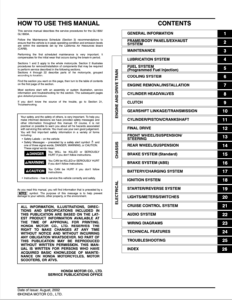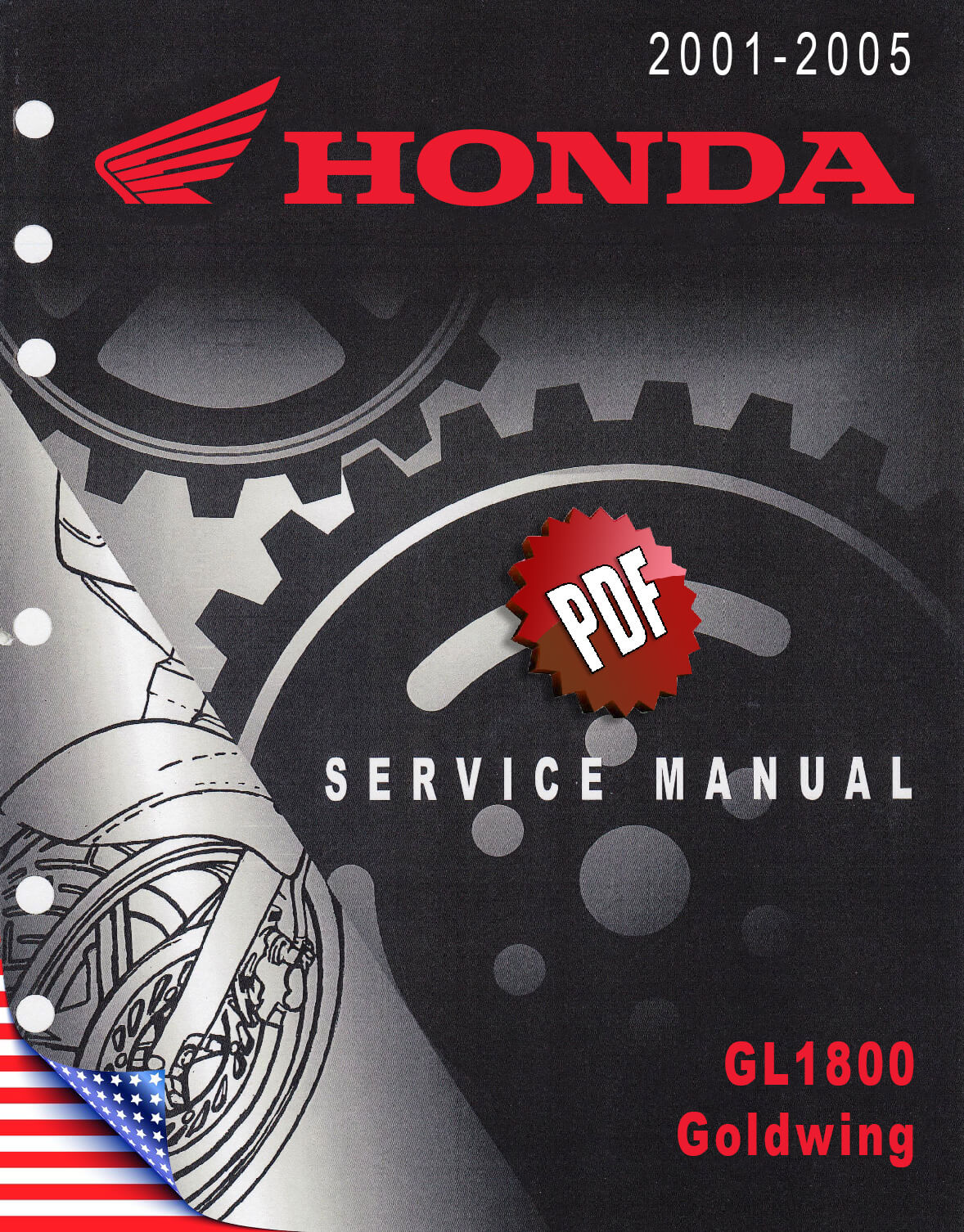Complete PDF version of the Service Manual for the Honda GL1800. A MUST for every Gold Wing owner.
Download: Immediately after payment!
OEM Original factory workshop manual.
Models covered by this manual: 2001-2010 but could be used throughout 2017
Number of pages: 757 pages
Table of contents:

This PDF repair manual can be downloaded right after the payment process in complete, on the device of your choice. You will also receive the download link by email along with your receipt.
We do not offer printed manuals, for the following reasons:
- it is more eco-friendly to use a digital version
- your manual never gets dirty or greasy
- you can always choose to print the specific page(s) you need to work on your bike
- you receive your manual immediately after payment
- it is searchable

Honda Gold Wing
Honda Gold Wing is a touring motorbike series produced by Honda. Shaft drive and a flat engine are standard on Gold Wings. The Gold Wing was introduced at the Cologne Motorcycle Show in October 1974 and quickly became a popular model in North America, Western Europe, Australia, and Japan.
The Gold Wing series
Total sales exceed 640,000, with the majority of them occurring in the United States. Gold Wings were produced in Marysville, Ohio, from 1980 until 2010, when production was terminated. There were no Gold Wings manufactured for the 2011 model year, and manufacturing began in Kumamoto Prefecture, Japan in 2011 utilizing tooling brought from the American facility.
One of the 240 Landmarks of Japanese Automotive Technology recognized by the Society of Automotive Engineers of Japan is a 1974 Honda Gold Wing GL1000. Honda GL models appeared eighteen times in Cycle World’s list of the ten best bikes from 2006 to 2012.
The Gold Wing saw several design revisions over its manufacturing lifespan, beginning in 1975 with a 999 cc (61.0 cu in) flat-four engine and progressing to a 1,832 cc (111.8 cu in) flat-six engine by 2001. Anti-lock braking, cruise control, electrically assisted reverse gear, an optional airbag, a fairing with heating and an adjustable windscreen, panniers and a trunk, a pillion backrest, satnav, and a six-speaker radio/audio system with MP3/iPod connectivity were all standard features on the 2012 model.
Gold Wing development
Following the triumph of the ground-breaking CB750 superbike in 1972, the firm created an R&D design team to investigate proposals for a new flagship motorbike. Shoichiro Irimajiri led the project, having created Honda’s multi-cylinder MotoGP engines and Formula One V12 engine in the 1960s.
The 1974 Gold Wing combined innovations from both prior motorcycle and automobile designs in its flat-four shaft-drive powerplant.
The Gold Wing was the first Japanese production motorcycle with a water-cooled four-stroke engine, while being predated by the 1971 water-cooled Suzuki GT750 two-stroke triple. In 1900, the first four-cylinder boxer engine was built.
Target market
The CB750 was known within Honda as the “King of Motorcycles” throughout its development, thus Honda’s next great item would be known as the “King of Kings.” Honda originally intended the Gold Wing to be a huge sport motorbike, but after seeing that consumers were “piling miles on tours,” Honda rethought the bike’s design goals, realizing that the core market for the Gold Wing was the long-distance motorcyclist/. In North America, a motorbike appropriate for that mission would require long-distance comfort, wind protection, a smooth ride, a comfortable seat, baggage storage, and plenty of power.
Long-distance bikers in America had only a few brands to select from in the early 1970s: Harley-Davidson, Moto Guzzi, and BMW. The Harley-Davidson Electra Glide was a comfortable, high-maintenance, and high-vibration motorbike with a devoted fan base. It was up against the 850cc Eldorado from Moto Guzzi. BMW bikes were smoother and more dependable, but more costly. Other large Japanese bikes, such as the Honda CB750 and the Kawasaki Z1, were less expensive, but they were not ideal tourers because to their limited fuel tanks and rear drive-chains that required frequent maintenance. The Gold Wing was intended at a newly developing market segment: a new type of American long-distance rider who would not purchase a Harley-Davidson or a BMW but would open their wallets for an economical bike that offered comfort, endurance, little maintenance, and a smooth, torquey, quiet engine.
The secondary target market for the Gold Wing was Europe, where riders valued handling and performance above luxury. (The Honda Pan European was created in response to the unique needs of the European market.)
5th generation
GL1800(SC47)
The 2001 GL1800 was the first new model in 13 years, featuring a bigger 1,832 cc (111.8 cu in) engine with fuel injection and increased output from 74 kW (99 bhp) to 87 kW (117 bhp). The GL1800’s extruded aluminum frame, which has 31 parts (just half the number of the GL1500), results in a lower total weight. ABS braking was available as an option.
The 2006 model added an airbag, an in-dash GPS called Internavi, with audio information delivered through the speakers and headset connections, and a rider “comfort package” consisting of saddle heating, heated grips, and adjustable engine-air vents forward of the driver’s foot pegs.
Update(SC68)
The 2010 model year was the last to be made in the United States, and no 2011 model year Gold Wings were produced before production was moved to Japan in 2012. Some dealers and aftermarket traders divide all GL1800 models into two categories: “First Generation” GL1800s manufactured in the United States (2001–2010) and “2nd Generation” GL1800s constructed in Japan (2012–2017).
The 2nd Gen GL1800 received minor changes, including restyled bodywork that made the fairing and saddlebags appear less bulbous yet being more capacious. A redesigned fairing provided improved leg protection, with vents channeling heated engine air into the rider’s feet. The trunk, fairing pockets, and saddlebags provided 150 litres of storage space (5.3 cu ft). The instrument panel now includes a brighter screen, an updated satellite navigation/radio, and a redesigned six-speaker audio system with MP3 and iPod compatibility.
Source: Wikipedia

